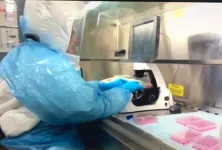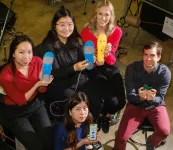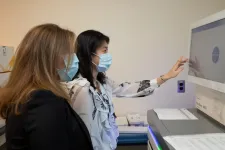(Press-News.org) Scientists at four leading Illinois research institutions, three in the Chicago region, are forming a new collaboration to study the effects of drought on urban trees and develop more effective drought response strategies nationwide through a grant from the National Oceanic and Atmospheric Administration (NOAA).
The project is being led by researchers at The Morton Arboretum in conjunction with the U.S. Department of Energy’s Argonne National Laboratory, the University of Chicago and the Illinois State Water Survey at the Prairie Research Institute.
“With the ongoing effects of climate change likely to make droughts and excessive heat events more common, healthy urban trees will play an increasingly important role in helping mitigate impacts on people’s lives,” said Christy Rollinson, the Arboretum’s forest ecologist and principal investigator on the project. “Trees provide a wealth of valuable ecological services, such as helping to keep cities cooler in the summer and absorbing groundwater to mitigate flooding.”
Those services make trees essential to a community’s capability to be resilient to the impacts of climate change. Negative climate change impacts include extreme weather events and flooding. According to M. Ross Alexander, assistant operation research analyst in Argonne’s Decision and Infrastructure Sciences division and scientist at large in the University of Chicago Consortium for Advanced Science and Engineering, “A mature oak tree can pump through 50 gallons of water a day. That is water that will not go down the sewers. If a tree experiences hard droughts or multiple droughts, this functionality could be impaired.”
The research enabled by the grant has three components focused on data gathering, action plans and creating guidelines for improved drought resilience in urban communities. After determining the common drought monitoring indices most associated with tree-scale drought response across the Chicago metropolitan region, the institutions will then partner with tree care professionals and residents to develop a multitiered recommendation and action strategy for communities to reduce the impacts of ecological drought on trees and plants. Finally, they’ll create guidelines for targeted tree planting strategies that will increase near- and long-term drought resilience in urban communities. This project will take place over the next two years.
“Droughts have typically been studied in an agricultural context,” Alexander said. “We want to add a new lens to the study of drought and see how drought can affect different ecosystems.”
“This project will greatly enhance our ability to monitor and provide an early warning for ecological drought impacts in real time, and provide useable information for decision makers in charge of urban tree management,” said Trent Ford, Illinois State Climatologist at the University of Illinois. “Through this partnership with The Morton Arboretum and Argonne, we’ll also be able to better inform urban tree planning to be more resilient to climate change now and into the future.”
The grant will also enable new ways of thinking, including creating a new early warning system for urban droughts. “By modeling near-term drought risk, we can start to determine the types of trees that will be able to withstand low-water conditions for different periods of time,” Rollinson said. “So when drought strikes urban areas, communities will be more prepared to mitigate its impacts.”
Changes in the urban arboreal landscape due to climate change and other risk factors like insect infestations or blight have led researchers to be forward-thinking about the kinds of trees that will perform best under different types of stressors, and that will meet a community’s long-term needs.
The study will be conducted in conjunction with urban planners and urban tree care professionals to help the researchers understand what is being planted and the care trees are currently receiving. “The urban ecosystem is complex,” Rollinson noted. “We want to understand how urban trees operate and interact within their environment to ensure we can properly care for them and that they’re effective when we need them during stressful drought periods.”
Funding for the work is provided by the NOAA Climate Program Office, through NOAA’s National Integrated Drought Information System.
About The Morton Arboretum
The Morton Arboretum is a world-renowned leader in tree science and research. Its 1,700 acre site contains 222,000 tree and plant specimens, representing 4,650 taxa from 40 countries. The Arboretum’s Center for Tree Science collaborates with researchers around the world, contributing scientific knowledge and technical experience to secure the future of trees. The Arboretum’s Global Tree Conservation Program leverages the expertise of the botanical garden community to protect and restore vulnerable and threatened trees. Additional information about the Arboretum’s scientific work and how it contributes to a greener, healthier world for future generations can be found at mortonarb.org.
About the Prairie Research Institute
The Prairie Research Institute conducts transformative research that provides innovative, at-scale solutions for a society undergoing climate and energy transitions. PRI unites scientific expertise in geology, ecology and biodiversity, archaeology, hydrology and water, weather and climate, pollution prevention, and sustainable energy to benefit the people, economy, and environment of Illinois, the nation, and the world. PRI comprises five state scientific surveys: the Illinois Natural History Survey, Illinois State Archaeological Survey, Illinois State Geological Survey, Illinois State Water Survey, and Illinois Sustainable Technology Center. PRI also oversees the Illinois Water Resources Center, which works with scientists, water professionals, and communities to address water resource challenges. Additional information about PRI can be found at https://prairie.illinois.edu/.
Argonne National Laboratory seeks solutions to pressing national problems in science and technology. The nation’s first national laboratory, Argonne conducts leading-edge basic and applied scientific research in virtually every scientific discipline. Argonne researchers work closely with researchers from hundreds of companies, universities, and federal, state and municipal agencies to help them solve their specific problems, advance America’s scientific leadership and prepare the nation for a better future. With employees from more than 60 nations, Argonne is managed by UChicago Argonne, LLC for the U.S. Department of Energy’s Office of Science.
The U.S. Department of Energy’s Office of Science is the single largest supporter of basic research in the physical sciences in the United States and is working to address some of the most pressing challenges of our time. For more information, visit https://energy.gov/science.
END
Four major Illinois research institutions form a collaboration to improve urban forest drought resilience
NOAA to fund Argonne, The Morton Arboretum, the University of Chicago and the University of Illinois Urbana-Champaign for climate work
2023-04-13
ELSE PRESS RELEASES FROM THIS DATE:
Good news! Only a modest reduction in added sugars consumption is needed to achieve the Healthy People 2030 target
2023-04-13
Ann Arbor, April 13, 2023 – Reducing caloric intake from added sugars is a Leading Health Indicator in Healthy People 2030, a national public health initiative led by the US Department of Health and Human Services that sets data-driven national objectives to improve health and wellbeing over the next decade. Although many Americans consume too much sugar, investigators found that only a modest reduction in added sugars intake is needed to reach a population mean of 11.5% of calories from added sugars by 2030. Prioritizing reducing added sugars intake among people not meeting recommendations could help those most at risk for chronic disease related to added sugars consumption. They report ...
T-cell vaccine for COVID-19 may last longer than current vaccines
2023-04-13
UNIVERSITY PARK, Pa. — The current COVID-19 vaccines are designed to trigger an antibody response to the SARS-CoV-2 spike protein, which is vulnerable to mutations that could make the vaccine less effective over time. Focusing on the T-cell instead, Penn State researchers partnered with Evaxion Biotech on a study that was the first to demonstrate the effectiveness of an artificial intelligence-generated vaccine in a live viral challenge model. Such a vaccine may provide long-lasting immunity against future emerging variants and could be used as a model for other seasonal viral diseases ...
Rice U. students engineer socks for on-the-go neuropathy treatment
2023-04-13
HOUSTON – (April 13, 2023) – Need a little spring — or buzz — in your step? A wearable electrical-stimulation and vibration-therapy system designed by Rice University engineering students might be just what the doctor ordered for people experiencing foot pain and balance loss due to diabetic neuropathy.
Rice engineering students in the StimuSock team — Abby Dowse, Yannie Guo, Andrei Mitrofan, Sarah Park and Kelly Xu — designed a sock with a smart insole that can deliver both transcutaneous electrical nerve stimulation (TENS) and vibration therapy that block pain signals to the brain and ...
UC Davis study finds tweets can amplify, disrupt, unite and divide
2023-04-13
Social media connects people and amplifies different aspects of humanity in good and bad ways. But the effects of social media appear neither universally good nor bad, but rather present an oscillating, dynamic system that can be divisive but also uniting, a new University of California, Davis, study suggests.
Department of Communication researchers said their findings both in an observational study and simulation speak to the ongoing debate about social media’s contributions to political polarization, misinformation and echo chambers. To conduct their research, ...
Highlights from the journal CHEST®, April 2023
2023-04-13
Glenview, Illinois – Published monthly, the journal CHEST® features peer-reviewed, cutting-edge original research in chest medicine: Pulmonary, critical care and sleep medicine and related disciplines. Journal topics include asthma, chest infections, COPD, critical care, diffuse lung disease, education and clinical practice, pulmonary vascular disease, sleep, thoracic oncology and the humanities.
The April issue of the CHEST journal contains 50 articles, including clinically relevant research, reviews, case series, commentary and more. ...
First-in-Canada clinical RNA sequencing platform may improve rare disease diagnostics in pediatrics
2023-04-13
A new clinical RNA sequencing platform at The Hospital for Sick Children (SickKids) is helping to facilitate research into rare genetic conditions and carve a path for Precision Child Health, a movement at SickKids to deliver individualized care for every patient.
RNA sequencing provides a different way of looking at the genes, by looking at how the body interprets the genetic code rather than looking directly at the genetic code itself. While DNA-based tests like genome sequencing take a picture of a person’s genetic code, scientists can better understand how the DNA is being read by also looking at RNA, which carries instructions for making ...
Durability of bivalent boosters against Omicron subvariants
2023-04-13
(CHAPEL HILL, N.C., April 13, 2023) New research led by the UNC Gillings School of Global Public Health shows that bivalent COVID-19 boosters are still providing effective protection from hospitalization and death, even against the most recent omicron subvariants.
Published this week in the New England Journal of Medicine (NEJM), researchers found that the bivalent boosters were 67% effective in preventing hospitalization and death in those who had been previously vaccinated or boosted. Effectiveness waned to 48% after four weeks, 44% after 10 weeks and 38% after 20 weeks.
Though ...
Improving the accuracy of near-infrared fluorescence in cardiovascular imaging
2023-04-13
Cardiovascular diseases (CVDs) or heart diseases are still the leading cause of death globally. Fortunately, doctors are now equipped with more advanced and sophisticated tools that help them diagnose CVDs. A prominent example is intravascular ultrasound (IVUS), which enables cardiologists to obtain images of the inside of blood vessels using a thin ultrasound probe. These images can then be used to assess problems such as the thickening of arteries caused by fat or plaque buildup.
While IVUS is undoubtedly a powerful ...
New tool to study hepatitis B could open the door to a cure
2023-04-13
Hepatitis C and hepatitis B viruses both attack the liver, eventually causing deadly cirrhosis or cancer. But while antivirals can cure 95 percent of HCV infections, its cousin HBV has long eluded effective therapeutics. As a result, nearly 1 million people die from HBV every year.
Now researchers from the lab of Rockefeller’s Charles M. Rice—who shared the 2020 Nobel Prize in Physiology or Medicine for pioneering novel methods to grow and study HCV—have developed an approach for studying HBV in the lab that ...
Biological bouncers: How immune cells yank antigens from surfaces to learn and evolve
2023-04-13
Most cells evolve slowly, accumulating incremental changes that better suit their environments. Immune cells, because they must adapt rapidly to counter new threats, evolve much more quickly. Part of that, UCLA physicists now report, rests on their ability to forcibly pull antigens off other cells’ surfaces and “study” them.
By using this type of mechanical force, the immune system’s B cells, which create antibodies that fight off harmful pathogens like viruses, bacteria and parasites by targeting their ...
LAST 30 PRESS RELEASES:
Sleeping in on weekends may help boost teens’ mental health
Study: Teens use cellphones for an hour a day at school
After more than two years of war, Palestinian children are hungry, denied education and “like the living dead”
The untold story of life with Prader-Willi syndrome - according to the siblings who live it
How the parasite that ‘gave up sex’ found more hosts – and why its victory won’t last
When is it time to jump? The boiling frog problem of AI use in physics education
Twitter data reveals partisan divide in understanding why pollen season's getting worse
AI is quick but risky for updating old software
Revolutionizing biosecurity: new multi-omics framework to transform invasive species management
From ancient herb to modern medicine: new review unveils the multi-targeted healing potential of Borago officinalis
Building a global scientific community: Biological Diversity Journal announces dual recruitment of Editorial Board and Youth Editorial Board members
Microbes that break down antibiotics help protect ecosystems under drug pollution
Smart biochar that remembers pollutants offers a new way to clean water and recycle biomass
Rice genes matter more than domestication in shaping plant microbiomes
Ticking time bomb: Some farmers report as many as 70 tick encounters over a 6-month period
Turning garden and crop waste into plastics
Scientists discover ‘platypus galaxies’ in the early universe
Seeing thyroid cancer in a new light: when AI meets label-free imaging in the operating room
Neutrophil-to-lymphocyte ratio may aid risk stratification in depressive disorder
2026 Seismological Society of America Annual Meeting
AI-powered ECG analysis offers promising path for early detection of chronic obstructive pulmonary disease, says Mount Sinai researchers
GIMM uncovers flaws in lab-grown heart cells and paves the way for improved treatments
Cracking the evolutionary code of sleep
Medications could help the aging brain cope with surgery, memory impairment
Back pain linked to worse sleep years later in men over 65, according to study
CDC urges ‘shared decision-making’ on some childhood vaccines; many unclear about what that means
New research finds that an ‘equal treatment’ approach to economic opportunity advertising can backfire
Researchers create shape-shifting, self-navigating microparticles
Science army mobilizes to map US soil microbiome
Researchers develop new tools to turn grain crops into biosensors
[Press-News.org] Four major Illinois research institutions form a collaboration to improve urban forest drought resilienceNOAA to fund Argonne, The Morton Arboretum, the University of Chicago and the University of Illinois Urbana-Champaign for climate work




